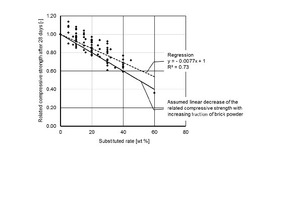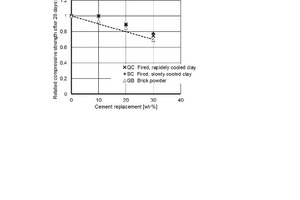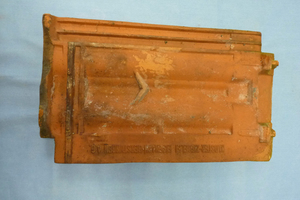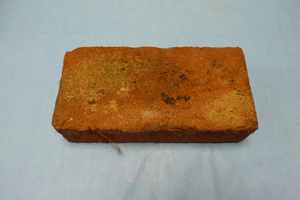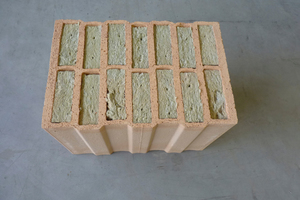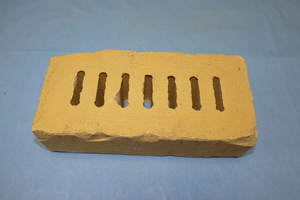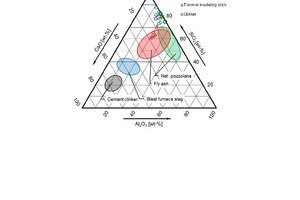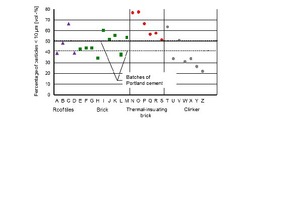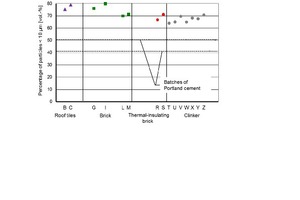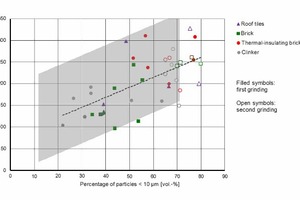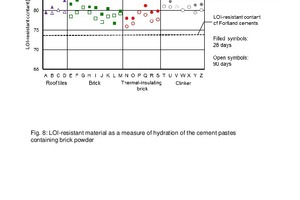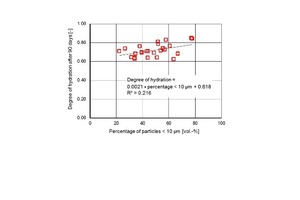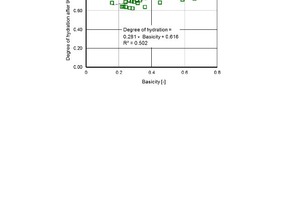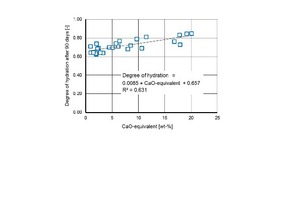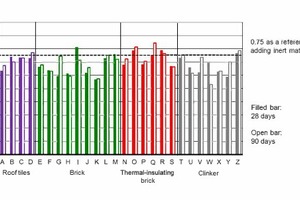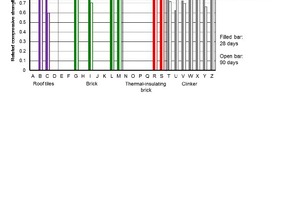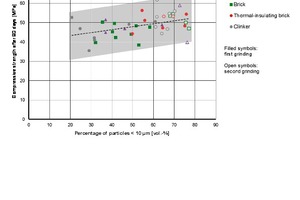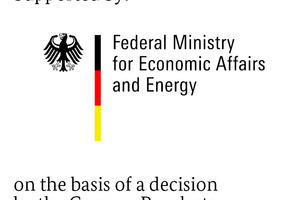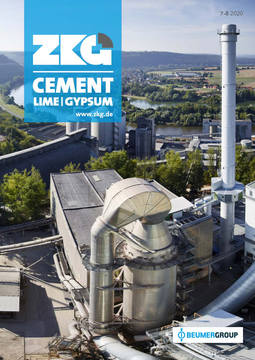REFERENCES
[1] Müller, A.: Fortschritte beim Recycling von Mauerwerkbruch (Teil 1). Ziegelindustrie International 2015, H. 1, pp. 20-26
[2] Winkler, A.: Herstellung von Baustoffen aus Baurestmassen. Shaker Verlag Aachen 2001
[3] O’Farrell, M.; Sabir, B. B.; Wild, S.: Resistance to chemical attack of ground brick-PC mortar. Part I. Sodium sulphate
solution. Cement and Concrete Research 29 (1999) 1781-1790
solution. Cement and Concrete Research 29 (1999) 1781-1790
[4] O’Farrell, M.; Sabir, B. B.; Wild, S.: Resistance to chemical attack of ground brick-PC mortar. Part II. Synthetic seawater. Cement and Concrete Research 30 (2000) 757-765
[5] O’Farrell, M.; Sabir, B. B.; Wild, S.: Pore size distribution and compressive strength of waste clay brick mortar.
Cement & Concrete Composites. 23 (2001) 81-91
Cement & Concrete Composites. 23 (2001) 81-91
[6] Toledo Filho, R. D.; Gonçalves, J. P.; Americano, B. B.; Fairbairn, E. M.: Potential for use of crushed waste calcined-clay brick as a supplementary cementitious material in Brazil. Cement and Concrete Research 37 (2007) 1357-1365
[7] Kae-Long Lin et al.: Waste brick’s potential for use as a pozzolan in blended Portland cement. Waste Management & Research (2009) 1-6
[8] Vejmelkova, E. et al.: Properties of high performance concrete containing fine-ground ceramics as supplementary
cementitious material. Cement & Concrete Composites 34 (2012) 55-61
cementitious material. Cement & Concrete Composites 34 (2012) 55-61
[9] Kartini, K.; Rohaidah, M. N.; Zuraini, Z. A.: Performance of Ground Clay Bricks as Partial Cement Replacement in Grade 30 Concrete. Open Science Index, Civil and Environmental Engineering Vol: 6, No: 8, 2012 waset.org/Publication/2626
[10] Bignozzi, M. C.; Saccani, A.: Ceramic waste as aggregate and supplementary cementing material: A combined action to contrast alkali silica reaction (ASR). Cement & Concrete Composites 34 (2012) 1141-1148
[11] Heidari, A.; Tavakoli, D.: A study of the mechanical properties of ground ceramic powder concrete incorporating
nano-SiO2 particles. Construction and Building Materials 38 (2013) 255-264
nano-SiO2 particles. Construction and Building Materials 38 (2013) 255-264
[12] Cheng Yunhong et al.: Test research on effects of ceramic polishing powder on carbonation and sulphate-corrosion
resistance of concrete. Construction and Building Materials 55 (2014) 440-446
resistance of concrete. Construction and Building Materials 55 (2014) 440-446
[13] Luiz Renato Steiner, L. R.; Bernardin, A. M.; Pelisser, F.: Effectiveness of ceramic tile polishing residues as supplementary cementitious materials for cement mortars. Sustainable Materials and Technologies 4 (2015) 30-35
[14] Kadam, S. D. et al.: Analysis of Ground Clay Brick as Supplementary Cementitious Material. International Journal
of Scientific & Engineering Research, Volume 6, Issue 12 (2015) 152-157
of Scientific & Engineering Research, Volume 6, Issue 12 (2015) 152-157
[15] Irki, I. et al.: 2017: Effect of Blaine fineness of recycling brick powder replacing cementitious materials in self compacting mortar. Journal of Adhesion Science and Technology (2017) 1-19
[16] Alesio, E. et al.: Use of clay-based construction and demolition waste as additions in the design of new low and very
low heat of hydration cements. Materials and Structures 51 (2018) 101, 1-12
low heat of hydration cements. Materials and Structures 51 (2018) 101, 1-12
[17] Letelier et al.: 2018 Influence of Waste Brick Powder in the Mechanical Properties of Recycled Aggregate Concrete.
Sustainability 2018, 10, 1037, 1-16
Sustainability 2018, 10, 1037, 1-16
[18] Rahhal, V. F. et al.: A. Complex Characterization and Behavior of Waste Fired Brick Powder-Portland Cement System. Materials 2019, 12, 1650, 1-20
[19] Zhiming Ma; Zhenhua Duan; Guangzhong Ba: Effects of an Applied Load on the Chloride Penetration of Concrete with Recycled Aggregates and Recycled Powder. Volume 2019, Article ID 1340803, 1-15
[20] Yasong Zhao et al.: 2020 The particle-size effect of waste clay brick powder on its pozzolanic activity and properties
of blended cement. Journal of Cleaner Production 242 (2020) 118521
of blended cement. Journal of Cleaner Production 242 (2020) 118521
[21] Beutner, N.: Zur Eignung und Wirkungsweise calcinierter Tone als reaktive Bindemittelkomponente im Zement.
Dissertation. Universität der Bundeswehr. 2017
Dissertation. Universität der Bundeswehr. 2017
[22] O’Farrell, M.; Sabir, B. B.; Wild, S.: Strength and chemical resistance of mortars containing brick manufacturing clays subjected to different treatments. Cement & Concrete Composites 28 (2006) 790-799
[23] Severins, K.; Müller, Ch.: R-Beton – Ressourcen schonender Beton (Teil 2). Verwendung von Brechsanden in der
Zementherstellung. 20. Internationale Baustofftagung 12. – 14. September 2018, Weimar
Zementherstellung. 20. Internationale Baustofftagung 12. – 14. September 2018, Weimar
[24] AFNOR, Association Francaise de Normalisation, Standard NF P 18-513:2010, Pozzolanic addition for concrete –
Metakaolin – Definitions, specifications and conformity criteria, 2010
Metakaolin – Definitions, specifications and conformity criteria, 2010
[25] Lothenbach, B.; Scrivener, K.; Hooton, R. D.: Supplementary cementitious materials. Cement and Concrete Research
41 (2011) 1244-1256
41 (2011) 1244-1256
[26] Snellings, R.; Mertens, G.; Elsen, J.: Supplementary Cementitious Materials. Reviews in Mineralogy and Geochemistry. May 2012, Vol. 74 pp. 211-278
[27] Müller, A.: Baustoffrecycling. Entstehung – Aufbereitung – Verwertung. Springer Vieweg 2018
[28] Müller, A. et al.: Entwicklungen zum Recycling von Ziegeln und Ziegelmauerwerk (Teil 2). Ziegelindustrie International. 2020, H. 3, pp. 20-26

